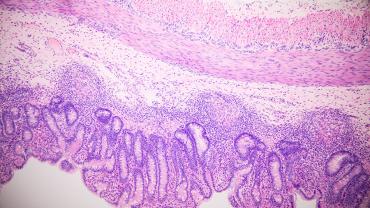
Bile salts aid in the digestion of fat and fat-soluble vitamins, but that is not the only role they play in the body. The gut microbiota metabolizes bile acids, and in return, bile acids play a role as regulators of the gut microbiome. Additionally, they act as signaling hormones to affect metabolism and inflammation, and associated disorders.
Bile acids support a healthy gut microbiome by exerting antimicrobial effects. The gut microbiome metabolizes primary bile acids (e.g., chenodeoxycholic acid and cholic acid) into secondary bile acids (e.g., lithocholic and deoxycholic acid). The conversion of conjugated to unconjugated bile acids also takes place in the gut microbiome. The microbiota also influences the size and diversity of the bile acid pool. There are specific bacteria that perform this act, so changes to the microbiome may alter the conversion of primary to secondary bile acids and affect health.
In one study, cirrhosis was associated with a decreased conversion of the primary to secondary bile acids, in addition to changes of the gut microbiome taxa. The group with cirrhosis, especially those with a more advanced case, exhibited signs of dysbiosis. Those with cirrhosis had a significantly higher abundance of Enterobacteriaceae and Veillonelllaceae bacteria and a lower abundance of autochthonous bacteria.
Bile acids act as signaling molecules by activating receptors, including farnesoid X receptor (FXR), pregnane X receptor (PXR), and they constitute androstane receptor (CAR), vitamin D receptor (VDR), and the G-protein receptor, TGR5. The actions of these receptors aid in modulating lipid, glucose, and energy metabolism, in addition to inflammation and immune responses. For example, FXR activation by bile acids has been shown to inhibit NF-kB activity and stimulate systemic anti-inflammatory effects. TGR5 decreases cytokine production and exerts other anti-inflammatory activities, which include inhibiting the NLRP3 inflammasome activation and protecting against lipopolysaccharide inflammation.
Chronic disorders associated with inflammation and metabolic dysfunction, such as type 2 diabetes and nonalcoholic fatty liver disorder are associated with changes in bile acid metabolism and pool composition. In one study, plasma levels of bile acids exhibited a positive association with fasting plasma levels and HOMA-IR. Another study found that patients with type 2 diabetes had more than twice the level of plasma bile acids compared to healthy controls. Additionally, in the healthy controls, there was an association between insulin resistance and composition of bile acids.
Supporting bile acid synthesis and metabolism may do more than aid fat digestion; this may also aid a normal microbiome, glucose metabolism, and a healthy inflammatory response. Many avenues may help stimulate optimal bile acid synthesis and metabolism, such as aiding a balanced microbiome by consuming a healthy diet with prebiotics and probiotics or stimulating bile flow with choleretic herbs. Some individuals may also find benefit from taking supplementary bile acids.
By Kendra Whitmire, MS, CNS